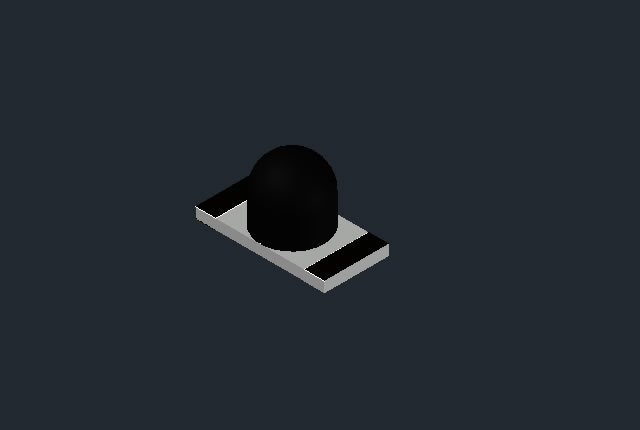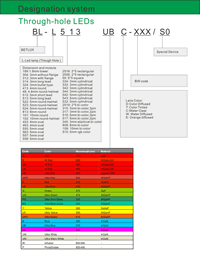smd-chip led
Series No:
Weight:(g/pcs)
Dimension:(mm)
Package:
Specification:
Inquiry
Description:
“Precision Illumination and Detection: Exploring Photodiode Types in 1206 SMD LED Dome Lens Technology”
Introduction
In modern electronic and optical systems, photodiode types play an essential role in converting light into electrical signals for measurement, sensing, and communication. One of the most reliable and efficient designs in this field is the 1206 SMD LED dome lens Photodiode, which offers compact size, high responsiveness, and exceptional optical clarity. Combining the structural integrity of a surface-mount LED with the functionality of Photodiode light technology, this component is a cornerstone in the development of smart sensors, remote controls, and automation systems.
The 1206 SMD LED package, enhanced by a dome lens, ensures optimal light focus and improved sensitivity to illumination across visible and infrared spectra. This design allows engineers and manufacturers to integrate Photodiode lights into compact electronic assemblies with high performance and reliability. Whether used in IR receiver LED lights or signal detection circuits, the Photodiode remains one of the most valuable tools in precision electronics.
Understanding Photodiode Types
There are several photodiode types in use today, each optimized for specific applications and wavelengths. The 1206 SMD LED dome lens Photodiode represents a refined version of these sensors, tailored for compact devices requiring both light detection and emission capabilities.
Main Types of Photodiodes Include:
-
PN Junction Photodiode:
The most common type, built with a simple p-n junction. It converts light energy directly into current, widely used in basic detection circuits. -
PIN Photodiode:
Features an intrinsic layer between the p and n regions, offering higher speed and sensitivity, suitable for optical communication and high-frequency detection. -
Avalanche Photodiode:
Provides internal gain through avalanche multiplication, ideal for extremely low-light environments and long-distance optical signal detection. -
Schottky Photodiode:
Offers very fast response times using metal-semiconductor junctions, perfect for ultra-high-speed electronics and precision measurement systems.
The 1206 SMD LED dome lens Photodiode often incorporates PIN characteristics, balancing sensitivity, speed, and compactness — essential for modern automation and Photodiode lights applications.
Features of 1206 SMD LED Dome Lens Photodiode
The 1206 Photodiode integrates the precision of optical sensing with the practical benefits of surface-mount design. Below are its distinctive technical and structural features:
-
Compact 3.2mm × 1.6mm SMD Package:
Optimized for dense PCB layouts, allowing flexible integration in miniature electronic devices. -
Dome Lens Design:
Enhances light focus and improves angular response, making it highly effective in IR receiver LED lights and remote-control systems. -
High Sensitivity to Infrared and Visible Light:
Capable of detecting a broad range of wavelengths, ensuring reliable operation across multiple lighting conditions. -
Fast Response Time:
Ideal for systems that require rapid detection or communication, including optical data transmission and industrial feedback systems. -
Low Dark Current:
Maintains high signal-to-noise ratio for precision sensing. -
Durability:
Built to withstand high operating temperatures, vibrations, and humidity — crucial for industrial and automotive environments. -
Surface-Mount Compatibility:
Enables fully automated placement and soldering, reducing production costs and improving consistency.
Applications of 1206 SMD LED Dome Lens Photodiode
The versatility of the 1206 SMD Photodiode makes it applicable across multiple fields of modern electronics. Its ability to detect and emit light efficiently supports a range of functions in both industrial and consumer products.
-
IR Communication Systems:
Acts as a key component in IR receiver LED lights for wireless data transmission, remote controllers, and smart devices. -
Optical Sensors:
Used in automatic lighting systems, motion detectors, and environmental sensors to measure light intensity and detect movement. -
Consumer Electronics:
The compact Photodiode lights are found in remote-control receivers, smart home devices, and display brightness sensors. -
Industrial Automation:
Plays a crucial role in object detection, counting, and machine vision systems requiring rapid optical feedback. -
Medical Equipment:
Used in pulse oximeters and diagnostic instruments to detect variations in light absorption through tissues. -
Safety and Security Devices:
Found in surveillance systems and light barriers, offering reliable object sensing and intrusion detection. -
Optical Communication Systems:
The Photodiode light efficiently converts modulated light into electrical signals for data transfer.
Benefits of Using 1206 SMD LED Dome Lens Photodiodes
The 1206 Photodiode offers several benefits that make it a preferred solution in precision electronics.
-
High Detection Accuracy:
The dome lens enhances light gathering capability, resulting in superior accuracy for detecting low-intensity light signals. -
Energy Efficiency:
With low power consumption and high conversion efficiency, it supports sustainable and compact designs. -
Compact Form Factor:
Its surface-mount configuration allows it to fit seamlessly into modern PCBs, reducing space requirements. -
Versatile Wavelength Range:
Works effectively across visible and infrared spectrums, ensuring flexibility in both IR receiver LED lights and optical sensors. -
Durability and Longevity:
Built with robust encapsulation materials, the Photodiode delivers consistent performance over years of continuous operation. -
Cost-Effective Manufacturing:
The SMD 1206 Photodiode supports automated assembly, lowering production time and improving quality control. -
Stable Output:
Delivers consistent results even under variable temperature and light conditions, crucial for industrial reliability.
Case Studies
Case Study 1 – Smart Home Systems (Germany):
A European home automation company integrated 1206 SMD Photodiodes into smart lighting controls. The Photodiode lights enabled precise ambient detection, automatically adjusting indoor brightness. The result was a 25% reduction in energy consumption while maintaining optimal comfort levels.
Case Study 2 – Medical Diagnostic Equipment (USA):
A medical technology manufacturer utilized Photodiode types in portable diagnostic tools. The Photodiode light provided real-time feedback for optical sensors, improving data accuracy in low-light conditions.
Case Study 3 – Automotive Safety Systems (Japan):
A leading car manufacturer adopted 1206 SMD Photodiodes in automatic headlight dimming systems. The IR receiver LED lights quickly detected oncoming traffic, adjusting beam intensity automatically, enhancing both driver visibility and road safety.
User Testimonials
Alex Chen, Electronics Engineer (China):
“We use the 1206 SMD Photodiode across multiple sensor modules. Its response speed and consistency are exceptional.”
Maria Gomez, Lighting Product Designer (Spain):
“The dome lens enhances light directionality perfectly for our IR receiver LED lights. Compact, durable, and easy to assemble.”
Jacob Smith, Automation Specialist (USA):
“Photodiode lights from this series are reliable even in harsh industrial environments. We’ve standardized them in all our systems.”
Conclusion
The 1206 SMD LED dome lens Photodiode is an outstanding innovation in optical sensing technology. Its compact size, energy efficiency, and high sensitivity make it a leading choice across industries — from consumer electronics to industrial automation.
As one of the most advanced photodiode types, it excels in converting Photodiode light into stable electrical signals, ensuring precision and reliability. Whether in IR receiver LED lights, diagnostic tools, or smart lighting systems, this diode delivers superior performance and durability.
The 1206 Photodiode reflects the evolution of Photodiode lights — compact, intelligent, and efficient — supporting the growing demand for reliable optical sensing in modern technology.

Features of 1206 SMD Photodiode Dome (Reverse Package):
- Compact 1206 package: 3.2mm x 1.6mm x 1.8mm.
- Photodiode with a dome and reverse package.
- Low power consumption for energy efficiency.
- Wide viewing angle for versatile visibility.
- Applications include remote control, IR wireless data transmission, and security alarms.
- Package: 3,000 pieces per reel.
- PB-Free for environmental safety.
- RoHS compliance for environmental consideration.
Possible Applications:
- Infrared remote control systems.
- IR wireless data transmission.
- Security alarm systems.
- Proximity sensors.
- Ambient light sensing.
- Smart home applications.
- Gesture recognition systems.
- Object detection.
- Optical encoders.
- Communication devices.
- Industrial automation.
- Medical equipment.
- Consumer electronics.
- Wearable technology.
- Smart appliances.
- Automotive applications.
- Robotics.
- Customized infrared projects.


Electrical-optical characteristics:
Package configuration & Internal circuit diagram
Obtain 3D specification files
To examine all 3D specifications, save the files to your local drive and open them with your 3D application.
Lens colors in 3D files are solely for visual representation; consult the Datasheet for accurate lens type and color information.
In the event of a mismatch, the dimensions in the datasheet take precedence over the 3D specifications.

All dimensions are in millimeters(inches)
Tolerance is +-0.25(0.01″) unless otherwise note
Specifications are subject to change without notice.
Partno description:
More Information
Lens Color:
| Code | D | T | C | W | E | |
| Meaning | color Diffused | Color Tinted | Water Clear | Water Diffused | Orange diffused |
Absolute maximum ratings (Ta=25°C)
| Parameter | SR | LR | UR | UE | UY | UG | PG | BG | B | UB | UV | W | Unit |
| Forward Current I F | 25 | 25 | 25 | 30 | 30 | 30 | 30 | 30 | 30 | 30 | 30 | 30 | mA |
| Power Dissipation P d | 60 | 60 | 60 | 65 | 65 | 75 | 110 | 110 | 120 | 120 | 120 | 120 | mW |
| Reverse Voltage V R | 5 | 5 | 5 | 5 | 5 | 5 | 5 | 5 | 5 | 5 | 5 | 5 | V |
| Peak Forward Current I PF (Duty 1/10 @1KHZ) | 150 | 150 | 150 | 150 | 150 | 150 | 150 | 100 | 100 | 100 | 100 | 100 | mA |
| Operation Temperature T OPR | -40 to +80 | °C | |||||||||||
| Storage Temperature T STG | -40 to +85 | °C | |||||||||||
| Lead Soldering Temperature T SOL | Max.260+-5°C for 3 sec Max. (1.6mm from the base of the epoxy bulb) | °C | |||||||||||
Related Information
Applied for:

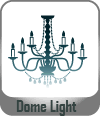

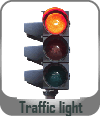
The LEDs described here are intended to be used for ordinary electronic equipment (such as office equipment,
communication equipment and household applications). Consult Betlux’s Sales in advance for information on
applications in which exceptional reliability is required, particularly when the failure or malfunction of the LEDs
may directly jeopardize life or health (such as in aviation, transportation, traffic control equipment, medical
and life support systems and safety devices).
CAUTIONS for Through-Hole LED Lamps
1. Application
The LEDs described here are intended to be used for ordinary electronic equipment (such as office equipment, communication equipment and household applications). Consult Betlux’s Sales in advance for information on applications in which exceptional reliability is required, particularly when the failure or malfunction of the LEDs may directly jeopardize life or health (such as in aviation, transportation, traffic control equipment, medical and life support systems and safety devices).
2. Storage
The storage ambient for the LEDs should not exceed 30℃ temperature or 70% relative humidity. It is
recommended that LEDs out of their original packaging are used within three months
For extended storage out of their original packaging, it is recommended that the LEDs be stored in a sealed
container with appropriate desiccant or in a desiccator with nitrogen ambient.
3. Cleaning
Use alcohol-based cleaning solvents such as isopropyl alcohol to clean the LED if necessary
4. Lead Forming & Assembly
During lead forming, the leads should be bent at a point at least 3mm from the base of LED lens. Do not use
the base of the leadframe as a fulcrum during forming.
Lead forming must be done before soldering, at normal temperature.
During assembly on PCB, use minimum clinch force possible to avoid excessive mechanical stress.

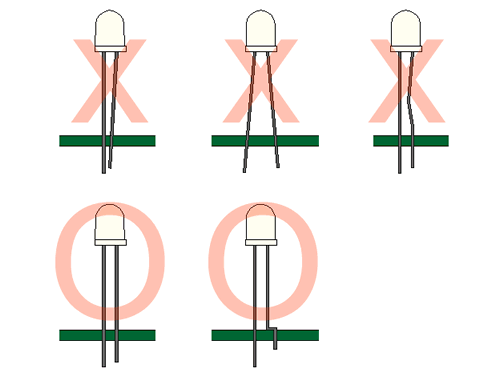
Soldering
When soldering, leave a minimum of 2mm clearance from the base of the base of the lens to the soldering point. Dipping the lens into the solder must be avoided.
Do not apply any external stress to the lead frame during soldering while the LED is at high temperature.
Recommended soldering conditions:
| IR Reflow Soldering (for SMD display) | Wave Soldering | Soldering Iron | |||
| Pre-Heat | 150-180°C | Pre-Heat | 100°C Max. | Temperature | 300°C Max. |
| Pre-Heat Time | 120sec Max. | Pre-Heat Time | 60sec Max. | ||
| Peak Temperature | 260°C Max. | SolderWave | 260°C Max. | Soldering Time | 3sec Max.(one time only) |
| Soldering Time | 10 sec Max. | Soldering Time | 5sec Max. | ||
Note: Excessive soldering temperature and/or time might result in deformation of the LED lens or failure of the LED
ESD(Electrostatic Discharge)
Static Electricity or power surge will damage the LED.
Suggestions to prevent ESD (Electrostatic Discharge):
n Use a conductive wrist band or anti-electrostatic glove when handling these LEDs
n All devices, equipment, and machinery must be properly grounded
n Work tables, storage racks, etc. should be properly grounded
n Use ion blower to neutralize the static charge which might have built up on surface of the LED’s
plastic lens as a result of friction between LEDs during storage and handling
ESD-damaged LEDs will exhibit abnormal characteristics such as high reverse leakage current,
low forward voltage, or “no light on” at low currents. To verify for ESD damage, check for “light on”
and Vf of the suspect LEDs at low currents.
The Vf of “good” LEDs should be>2.0V@0.1mA for InGaN product and >1.4V@0.1mA for AlInGaP
product.

Drive Method
An LED is a current-operated device. In order to ensure intensity uniformity on multiple LEDs connected in
parallel in an application, it is recommended that a current limiting resistor be incorporated in the drive circuit,
in series with each LED as shown in Circuit A below.
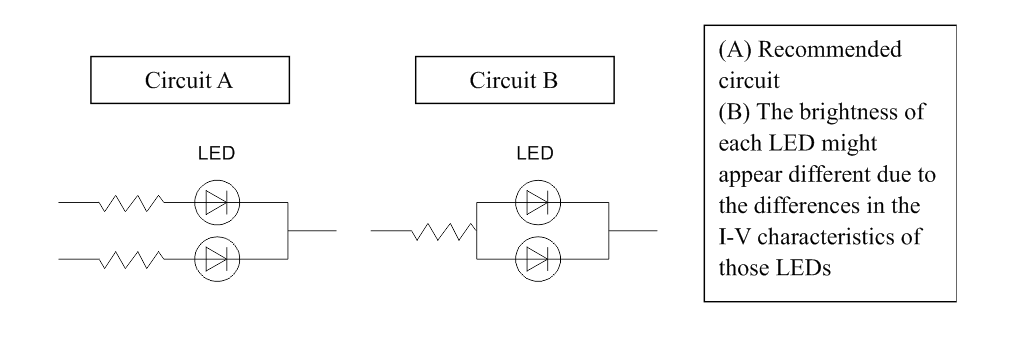
When selecting power for LED systems, it’s essential to understand several key parameters to ensure safe operation, longevity, and optimal performance. Here are some steps and considerations for LED power selection:
- Determine the Forward Voltage (Vf) of the LED(s):
Each LED has a forward voltage, which is the voltage at which the LED operates when the current is flowing through it. This value can typically be found in the LED’s datasheet.
- Determine the Forward Current (If) of the LED(s):
The forward current is the current at which the LED is designed to operate. Running an LED at higher than its rated current can reduce its lifespan and increase the heat it produces.
- Decide on the Configuration:
Series Configuration: When LEDs are connected in series, the forward voltages add up, but the current remains the same.
Parallel Configuration: When LEDs are connected in parallel, the forward voltage remains the same, but the currents add up. This configuration can be risky because if one LED fails or has a slightly lower forward voltage, it can cause the other LEDs to draw more current.
Calculate Total Power Requirements:
Power (W) = Total Forward Voltage (V) x Total Forward Current (A)
For example, if you have three LEDs connected in series, each with a forward voltage of 3V and a forward current of 20mA, the total power requirement would be:
Power = (3V + 3V + 3V) x 20mA = 9V x 0.02A = 0.18W
- Select an Appropriate Power Supply:
- Voltage Rating: The power supply voltage should match or slightly exceed the total forward voltage of your LED configuration.
- Current Rating: The power supply’s current rating should meet or exceed the total forward current of your LED configuration.
- Safety Margin: It’s a good practice to select a power supply that can provide at least 20% more power than your calculated requirement. This ensures the power supply isn’t operating at its maximum capacity, which can extend its life and ensure safer operation.
- Consider Additional Features:
- Dimming Capability: If you want to control the brightness of your LEDs, choose a power supply with dimming capabilities.
- Overcurrent and Overvoltage Protection: To protect your LEDs, select a power supply with built-in protection mechanisms.
- Thermal Management: Ensure that the power supply has adequate cooling, especially if it will be enclosed or in a location with limited airflow.
- Regulation and Efficiency:A power supply with good regulation will maintain a consistent voltage output despite variations in the load. High efficiency ensures minimal power is wasted as heat.
- Physical Size and Form Factor:Depending on where you plan to place the power supply, its size and shape may be critical factors.
In summary, when selecting power for LED systems, understanding your LED’s requirements and the configuration you plan to use is essential. Then, pick a power supply that meets those needs with some added safety margin, keeping in mind any additional features or constraints relevant to your project.
Here are some well-regarded brands in the industry:
- Mean Well: One of the most recognized brands in the LED power supply industry, Mean Well offers a wide range of products suitable for both indoor and outdoor applications. Their units often come with features like overcurrent protection, dimming capabilities, and high efficiency.
- Tridonic: A global leader in lighting technology, Tridonic offers LED drivers and power supplies that cater to various lighting solutions, from simple setups to advanced smart lighting systems.
- Philips Advance Xitanium: Philips is a well-known brand in the lighting industry, and their Xitanium series of LED drivers are known for reliability and performance. They cater to both indoor and outdoor LED applications.
- Osram: Another giant in the lighting industry, Osram offers a range of LED drivers and power supplies suitable for various applications, including architectural and street lighting.
- LIFUD: Specializing in LED drivers, LIFUD is known for its high-quality products that cater to both commercial and residential LED lighting solutions.
- MOSO: This brand offers a variety of LED drivers, especially for outdoor and industrial applications. Their products are known for durability and performance.
- TDK-Lambda: With a history in power electronics, TDK-Lambda offers a range of power supplies and LED drivers suitable for various applications, emphasizing reliability and advanced features.
